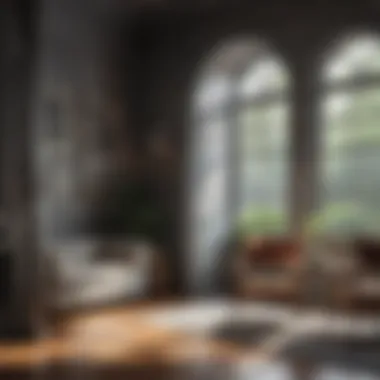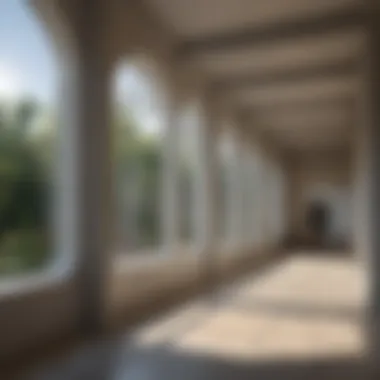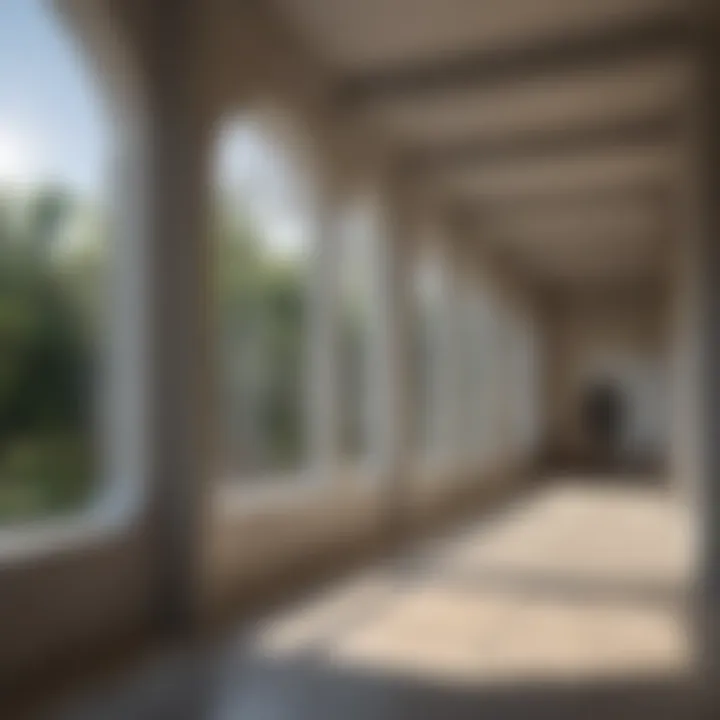In-Depth Look at PVC Pipe Schedule 40 Properties and Uses


Intro
In the rapidly evolving home improvement industry, PVC Pipe Schedule 40 stands as a stalwart choice for many applications. When it comes to piping solutions, understanding the ins and outs of PVC materials is crucial. PVC, or polyvinyl chloride, is widely utilized due to its balance of durability, affordability, and ease of installation. Its Schedule 40 designation refers to its wall thickness and pressure rating, making it a reliable choice for numerous residential projects.
The importance of knowing about PVC Pipe Schedule 40 cannot be overstated. From plumbing and irrigation to drainage systems, its versatility is noteworthy. Homeowners embark on projects, be it fixing a leaky faucet or installing a new irrigation system; also, understanding the distinct properties and applications of this type of piping can save time and money in the long run. Being informed on these aspects will empower homeowners and DIY enthusiasts alike to make better choices during their projects.
Understanding PVC Pipe Schedule
When it comes to plumbing and piping systems, the materials chosen play a pivotal role in determining the efficiency and longevity of the infrastructure. PVC Pipe Schedule 40 has become a go-to option for many homeowners and industry professionals, thanks to its balance of strength, cost, and versatility. Knowing its characteristics can help in making informed decisions regarding installation and utilization in various applications.
Understanding PVC Pipe Schedule 40 involves delving into what makes it unique compared to other options on the market, particularly when it comes to residential use. The size, wall thickness, and pressure ratings are significant factors to grasp and apply appropriately in different scenarios. Moreover, comprehending its properties can aid in recognizing constraints and advantages, which will ultimately affect performance.
Definition and Basic Characteristics
PVC Pipe Schedule 40 is a type of polyvinyl chloride piping specifically designed for various applications, primarily in plumbing and industrial systems. The “schedule” refers to the thickness of the pipe walls, which directly influences its pressure-handling capabilities. Schedule 40 pipes have a standard wall thickness, making them suitable for low to moderate-pressure applications.
The most prominent characteristics of PVC Pipe Schedule 40 include:
- Material Composition: Made of polyvinyl chloride, a strong and durable plastic that resists corrosion and weathering.
- Weight and Flexibility: Lightweight and easy to work with, reducing handling costs during installation.
- Pressure Rating: Typically, it can handle pressures of up to 140 psi at room temperature.
- Temperature Tolerance: Works well in a range of temperatures but may not be suitable for extreme heat applications.
These characteristics make it a versatile choice for residential plumbing, irrigation systems, and more, thus catering to a broad audience, including homeowners.
Comparative Analysis with Other PVC Schedules
Comparing PVC Pipe Schedule 40 with other commonly used schedules is essential to understanding its positioning in the market. Schedule 20 and Schedule 80 are two variants that often pop up in discussions about PVC piping. Each has its pros and cons that are worth noting.
Schedule
Schedule 20 PVC pipe is lighter and thinner than Schedule 40, making it an attractive choice for low-pressure systems like drainage or vent applications. Key characteristic: It is primarily designed for lower pressure applications, which may skew some users toward other options when high durability is a must.
The primary advantage of Schedule 20 is its cost-effectiveness; it generally comes at a lower price point, which can benefit DIY enthusiasts and budget-conscious homeowners. However, this comes at a cost of durability and resistance to pressure, which may not meet demands in more critical installations.
Unique feature: Its lightweight design translates to ease of transport and installation. While it may suit projects that demand non-potable water, its use in high-pressure scenarios can be dubious.
Schedule
On the flip side, Schedule 80 boasts a thicker wall which allows it to handle higher pressures securely, suitable for industrial applications like chemical transfer and heavy-duty plumbing operations. This schedule is indeed a favorite among professionals needing a robust piping solution.
Key characteristic: Schedule 80 pipes are recognized for their resilience and are rated for higher pressure, making them ideal for severe conditions. You might find them in commercial settings or operations subjected to intense wear and tear.
Unique feature: Its thick walls provide it with added strength and durability, though at a heftier price. Thus, while it may represent a sound investment for critical applications, the cost can be a deterrent for those seeking simple home plumbing solutions.
"Choosing the right schedule can mean the difference between a secure installation and costly repairs down the line."
Material Properties of PVC Pipe Schedule
Understanding the material properties of PVC Pipe Schedule 40 is pivotal for several reasons, particularly when making decisions about infrastructure and plumbing. These properties ensure viability in different applications and environments. Every project, be it small or large-scale, hinges on choosing the right materials. The characteristics of PVC, such as its chemical resistance, mechanical strength, and thermal stability, play a critical role in its overall performance. Here’s a deeper dive into these essential aspects.
Chemical Resistance
PVC Pipe Schedule 40 is renowned for its impressive chemical resistance. This quality holds significant importance in various contexts, particularly for homeowners and industrial applications. Unlike some materials that can be swiftly corroded by various chemicals, PVC remains resilient. It can handle many substances, including water, salt solutions, and even some acid-based cleaners without deteriorating.
In practical terms, this means that homeowners can use PVC pipes safely in their plumbing systems and irrigation setups without worrying about damage from common household chemicals. However, there are limits. For instance, prolonged exposure to ketones or strong oxidizing agents might cause degradation of the PVC. Therefore, always check the specific chemical compatibility when installing.
Mechanical Strength and Durability
When considering the mechanical strength of PVC Pipe Schedule 40, it’s hard to miss its robust nature. Designed to withstand significant pressure, it is a go-to choice for residential and commercial applications alike. The pipe is ranked to handle internal pressures that can reach up to 280 psi at 73°F. This capability ensures it can support water flow effectively in a variety of systems, from irrigation networks to home plumbing.
Durability is another essential aspect. PVC is not prone to rust or corrosion and offers a lifespan often exceeding 50 years when properly installed and maintained. Moreover, resistance to low impact makes it suitable for various climates, including those where dirt shifts and ground movement might be a concern.
"Each foot of PVC not only ensures longevity but also peace of mind for those planning long-term infrastructures."
Thermal Properties of PVC
The thermal properties of PVC Pipe Schedule 40 warrant careful consideration. This plastic material exhibits stability within a certain temperature range. Generally, PVC maintains effectiveness in conditions as low as 32°F and can tolerate temperatures up to approximately 140°F without degrading.
However, extremes on either end might impact the material. Cold temperatures can render PVC brittle, while excessive heat can lead to softening—if you’re in a region with temperature swings, that’s crucial to keep in mind. This thermal behavior also affects installation; rather than using regular tolls, specific tools must be applied to prevent its deformation during assembly or installation.


Applications of PVC Pipe Schedule
PVC Pipe Schedule 40 finds its significance in a multitude of applications across residential, industrial, and commercial settings. Its versatility stems from the balance it strikes between cost, durability, and performance. Understanding the various applications helps professionals make informed decisions, ensuring they select the right piping for their projects. This section outlines some key applications, delving into the specific benefits and features that make PVC Pipe Schedule 40 a popular choice.
Residential Plumbing Systems
Irrigation
Irrigation systems are essential for maintaining healthy gardens and landscapes. PVC Pipe Schedule 40 serves as a reliable option for these systems, thanks to its durability and resistance to weather elements. One key characteristic of irrigation is its ability to transport water efficiently without leaks. This is especially important for home gardens, where consistent moisture can mean the difference between flourishing plants and those past their prime.
The unique feature of using PVC here lies in its lightweight nature, making installation a breeeze. Homeowners appreciate how easy it is to handle and assemble, saving both time and labor costs. However, while it excels in various uses, PVC must be shielded from prolonged direct sunlight to prevent degradation.
Drainage
When it comes to drainage systems, PVC Pipe Schedule 40 is favored for its smooth interior surface, which minimizes clogs and allows for efficient water flow. This aspect is critical, especially in areas where heavy rain could lead to flooding. PVC's strength against chemicals is another bonus for residential drainage systems, ensuring it withstands potential corrosive substances.
A distinct advantage is its non-corrosive nature, which means less frequent replacement compared to metal pipes. Nevertheless, it might not handle extreme temperatures as effectively as other materials, so some caution is warranted during installation.
Industrial Applications
Chemical Transfer
In industrial settings, transferring chemicals safely is of utmost importance, and PVC Pipe Schedule 40 rises to the occasion. Its resistance to many acids and bases makes it a go-to for chemical handling. One major characteristic that sets it apart is its compatibility with a variety of substances, enabling businesses to operate efficiently without worrying about leaks or pipe fails.
The unique feature of employing PVC in chemical transfer systems is its affordability compared to alternatives like metal. This cost-effectiveness does not come at the expense of safety; however, users should conduct thorough research to ensure PVC is suitable for the specific chemicals involved. The downside includes potential temperature limitations that could affect use in high-temperature applications.
Water Treatment
Water treatment facilities need reliable piping solutions, and PVC Pipe Schedule 40 serves this purpose remarkably well. Its chemical resistance not only handles different treatment processes but also prevents contamination in the water supply. A key characteristic of this application is the overall integrity it upholds for clean water streams, contributing to public health.
The unique feature of using PVC in water treatment is its long service life, leading to reduced maintenance costs over time. One downside, however, is the need for periodic inspections to ensure ongoing safety and compliance with local regulations.
Commercial Uses
HVAC Systems
In the realm of HVAC (heating, ventilation, and air conditioning), PVC Pipe Schedule 40 plays a vital role. Its lightweight, ease of installation, and resistance to corrosion make it a practical choice for air ducting systems. A major characteristic of its use in HVAC applications is the efficient airflow it provides, which can lead to improved energy savings.
One notable feature of this application is its ability to minimize noise levels, making it a popular choice for indoor installations. However, like with other uses of PVC, care must be taken regarding temperature extremes, as some systems may require additional insulation to maintain efficiency.
Fire Protection
Fire protection systems often need to meet strict building codes, and PVC Pipe Schedule 40 can fit the bill under certain conditions. Its lightweight structure allows for easier installation, making it a popular option in commercial buildings. A critical characteristic is its ability to withstand impacts, which is crucial in places like warehouses where manned vehicles could pose threats to physical structures.
In terms of unique features, when fused properly, PVC can contribute to a reliable system that can be kept under pressure without leaks. While suitable for various applications, users should remain cautious about operational limits to prevent potential failures in critical situations.
PVC Pipe Schedule 40 is a flexible, cost-effective solution for various plumbing applications but requires careful consideration of specific use-case scenarios for optimal safety and performance.
In summary, PVC Pipe Schedule 40 serves a plethora of applications, with each section showcasing specific advantages and important characteristics. By exploring these uses, homeowners and industry professionals alike can appreciate the vital role that this type of piping plays in modern plumbing.
Installation Considerations for PVC Pipe Schedule
When tackling the nuances of PVC Pipe Schedule 40, it's vital to consider various installation aspects for optimal performance and longevity. Improper installation can lead to a world of headaches, so understanding the best practices and potential pitfalls is not just helpful, but necessary.
Cutting and Joining Techniques
Cutting and joining PVC pipes might seem straightforward, yet a few critical techniques can make or break the installation process. For cutting, tools like fine-toothed saws or specialized PVC cutters tend to yield the most precise results. It's essential to make a clean, straight cut; jagged edges can create sealing issues later on. After cutting, a gentle ream of the pipe's edges will prevent burrs from interfering with fittings.
When it comes to joining, solvent cement is the go-to for most Schedule 40 applications. However, it's not just about slapping some glue on; applying it right is crucial. Start by cleaning the surfaces to be bonded with a PVC cleaner to remove any dirt or grease. Be generous but controlled with the cement. Too much can lead to drips that interfere with pressure, while too little can result in weak joints. When fitting them together, twist the pipe slightly to ensure an even spread of cement. After joining, allow the appropriate curing time, typically around 24 hours, before applying pressure.
"Proper cutting and joining techniques can save both time and resources in the long run."
Fittings and Accessories
Fittings and accessories play a pivotal role in the functionality of PVC systems. Using the right fittings ensures that your layout remains tight and leak-free. Standard fittings like elbows, tees, and caps are ubiquitous, but make sure to choose the schedules that match your pipe’s specifications. Mismatched schedules can lead to weaker connections and compromised integrity.
When selecting accessories, consider not just the type, but also their intended use. For example, threaded fittings can connect to metal pipes easily, while slip fittings offer a simpler seal for PVC. Also, keep an eye out for drain or vent fittings that may need special configurations. As a general tip, always dry-fit your components before cementing. This way, you can visualize your assembly and catch potential issues before committing.


Code Regulations and Compliance
Adhering to local code regulations and compliance standards cannot be stressed enough when using PVC Pipe Schedule 40. These regulations exist to ensure safety and functionality and typically dictate not only installation procedures but also permissible applications.
Familiarize yourself with your local plumbing codes. They often reference the ASTM D1785 and NSF/ANSI 14 standards for PVC pipes and fittings. These standards define thresholds for pressure ratings, material quality, and even acceptable uses. Non-compliance not only risks fines or legal issues; it can also jeopardize the integrity of your system.
Moreover, certain applications, like in potable water systems, have stringent regulations that must be followed meticulously. Always consult with local authorities or plumbing professionals to ensure your project meets regulatory requirements. This foresight not only helps in avoiding future complications but ensures that your efforts and investments pay off in the long haul.
Advantages of Using PVC Pipe Schedule
The use of PVC Pipe Schedule 40 has much to offer, particularly for those diving into plumbing projects or other applications. The advantages range from cost-efficiency to the ease of use, making it a favorable choice in various circumstances. This section will guide you through these benefits, providing insights for homeowners and DIY enthusiasts looking to make informed decisions.
Cost-effectiveness
One of the standout features of PVC Pipe Schedule 40 is its cost-effectiveness. Homeowners on a budget appreciate how affordable these pipes are compared to alternatives like copper or steel. The lower price tag doesn’t mean you’re compromising on quality either. PVC pipes tend to have a longer life cycle, reducing replace frequency.
Moreover, with PVC being light in weight, shipping costs and handling are cut down significantly, which translates to overall savings. Most communities find that using PVC pipes in home projects results in fewer expenses over time, thanks to low material costs and minimal maintenance needs.
A few key points to consider about the cost-effectiveness of PVC Pipe Schedule 40:
- Lower Material Costs: PVC pipes are often cheaper to purchase than metal counterparts.
- Reduced Installation Costs: Their lightweight nature allows for easier handling, reducing labor costs.
- Less Maintenance Required: Once installed, these pipes typically require little upkeep.
Weight and Handling Benefits
Weight is another significant advantage of PVC Pipe Schedule 40. Being substantially lighter than metal options, installation becomes much easier. For homeowners or contractors maneuvering pipes through tight spaces, this is a welcomed perk.
Another note worth mentioning is that lighter pipes are generally easier to transport. If you're doing the work yourself or relying on a team, fewer complications arise from moving heavy materials around. This ease of handling can result in quicker project timelines as well.
Using lightweight materials is increasingly crucial in construction. Here is how the weight aspect plays out:
- Improved Portability: Easier to carry and manipulate at the site.
- Streamlined Installation: Cut down on labor hours, as one person can handle longer lengths without assistance.
Longevity and Maintenance
PVC Pipe Schedule 40 also shines when it comes to longevity and low maintenance. Its durability makes these pipes resistant to elements that might cause corrosion or degradation. They do not rust, rot, or suffer from scale buildup, common in metal pipes. This results in a longer lifespan that homeowners can rely on.
Regular inspections and maintenance are essential for any plumbing system, but the demands for PVC are significantly lower. A simple visual check for cracks or blocks, and you’re generally in the clear.
Consider these points regarding Longevity and Maintenance:
- Resistance to Corrosion: Doesn't rust or corrode like metal pipes.
- Durable in Various Conditions: Performs well against chemicals and climatic changes.
- Minimal Upkeep: Easy to clean and maintain, allowing peace of mind for users.
"PVC Pipe Schedule 40 stands as a preferred choice for plumbing due to its combination of affordability, ease of handling, and resilience."
In summary, when considering the advantages of using PVC Pipe Schedule 40, think about how it combines cost savings, lightweight nature, and low maintenance into a highly effective plumbing solution. Whether you're installing a new system or upgrading an existing one, understanding these benefits helps in making the best choice for your needs.
Limitations of PVC Pipe Schedule
While PVC Pipe Schedule 40 displays a plethora of advantages, it's crucial to address its limitations to ensure proper application. Ignoring these pitfalls could lead to costly repairs and unsafe systems. Therefore, understanding the constraints related to temperature sensitivity, pressure restrictions, and UV degradation holds substantial importance for homeowners and industry professionals alike.
Temperature Sensitivity
PVC pipes are known for their impressive resilience, but they are not immune to the effects of temperature fluctuations. When temperatures drop significantly, PVC can become more brittle. This brittleness can lead to cracking if subjected to significant stress or impact. For instance, if a homeowner installs PVC piping in a location that experiences extreme cold without proper insulation, there’s a good chance those pipes might shatter under pressure.
Conversely, at high temperatures, PVC can soften and lose its structural integrity. This may result in sagging or warping, impacting water flow or leading to potential leaks. It's worth noting that constant exposure to temperatures above 140°F can greatly affect performance. Therefore, for applications involving hot water or high-temperature environments, seeking alternatives or using specialized fittings could prove prudent.
"Understanding temperature sensitivities not only safeguards your installation but could also save you from headaches down the line."
Pressure Restrictions
Pressure capacity is another critical factor when considering PVC Pipe Schedule 40. It is designed to withstand moderate pressure, but exceeding its pressure rating can spell disaster. Each diameter of PVC pipe has a specific pressure rating, and pushing beyond this limit can lead to cracks or bursts.
Let's take an example: imagine a homeowner connecting a new irrigation system that upped the ante on pressure levels. If those PVC pipes are rated for 140 PSI and the system operates at 200 PSI, then the likelihood of a leakage or catastrophic failure is alarmingly high.
Thus, when selecting PVC pipes, one must consider not only the pressure specs of the current system but also any potential future changes that could result in increased pressure on the pipes, ensuring a safe and durable installation.
Potential for UV Degradation


PVC pipes exposed to sunlight for extended periods can be susceptible to UV degradation. The ultraviolet rays can lead to a breakdown of the plastic material, resulting in brittleness and discoloration. Over time, the pipe may weaken significantly to the point where it could fail.
To mitigate this risk, many manufacturers recommend covering the pipes or painting them with a UV-resistant coating. Homeowners often overlook this, thinking PVC is impervious to outdoor conditions. However, simply placing PVC pipes above ground in direct sunlight without any protective measures can shorten their lifecycle dramatically.
Regulatory Standards and Certifications
When it comes to using PVC Pipe Schedule 40, understanding the regulatory frameworks and certifications involved plays a crucial role. These standards dictate not just the safety and reliability of the pipes but also ensure that they are fit for the various applications for which they are intended. Homeowners often overlook this aspect, assuming that all products are created equal, but that couldn't be further from the truth. Complying with established regulations can save you from future headaches, whether it be leaks or more serious structural issues.
ASTM Standards
The American Society for Testing and Materials (ASTM) sets many of the standards that govern PVC pipe manufacturing. Compliance with ASTM standards is not merely a bureaucracy; it provides a benchmark for both quality and performance. For PVC Pipe Schedule 40, the ASTM D1785 standard specifies the dimensions, material properties, and testing methods that ensure the pipes meet rigorous performance expectations.
This particular standard covers several key aspects:
- Material Quality: The pipes must be made from high-quality polyvinyl chloride, ensuring longevity and resilience against environmental stresses.
- Dimensional Accuracy: Adhering to strict guidelines about sizing means that fittings and joints will align properly when installed, preventing leaks and other connection issues.
- Performance Testing: Manufacturers must conduct tests for various attributes like burst pressure, which guarantees that the pipes can handle the intended loads in real-world conditions.
Homeowners should always look for the ASTM markings on pipes. This insignia can serve as a badge of assurance, indicating that the product adheres to these stringent standards. For those undertaking renovations or new installations, it’s a critical consideration that should not be ignored.
NSF Approval
Another significant certification you might encounter is NSF (National Sanitation Foundation) approval. This is particularly important when the PVC pipes will be used for potable water applications. Getting NSF certification means that the product has been independently tested and meets public health and safety standards.
Key points regarding NSF approval include:
- Effect on Drinking Water: NSF-approved pipes are certified to not leach harmful chemicals into the water supply, making them a safer choice for homes.
- Quality Assurance: This approval provides homeowners with peace of mind, knowing that the materials they’re bringing into their homes meet rigorous testing and quality criteria.
- Local Code Requirements: Many jurisdictions require NSF-certified products for plumbing applications that involve drinking water, meaning using non-certified products could lead to compliance issues.
Ultimately, investing in ASTM-compliant and NSF-approved PVC Pipe Schedule 40 means you're laying a solid groundwork for any plumbing project. It not only enhances the longevity and safety of the installation but also adheres to laws and regulations, saving you from future problems down the line. Always ask questions and do the due diligence to ensure your choices will lead to beneficial outcomes for your home.
Maintenance and Care for PVC Pipe Schedule
Proper maintenance and care for PVC Pipe Schedule 40 are essential to ensure the longevity and efficiency of the piping systems installed in residences and commercial spaces. While PVC is known for its durability and low maintenance needs compared to other materials, neglecting regular checks and care can lead to costly repairs and replacements down the line. Understanding the importance of maintaining this type of piping not only safeguards your investment but also enhances the overall functionality of your plumbing or drainage system.
Regular Inspection Routines
Engaging in regular inspection routines can prevent minor issues from escalating into significant headaches. A well-planned inspection not only saves money but also helps to identify problems that could affect the integrity of your plumbing. Here’s what to look out for during inspections:
- Visual Checks: Look for signs of wear and tear, cracks, or physical damage. Keep an eye on joints and fittings where leaks may develop.
- Pressure Testing: For applications that deal with water or liquids under pressure, conducting a pressure test can help identify leaks that are not visible.
- Cleanliness: Ensure that there’s no debris or build-up around the pipes. Blocked pipes can hinder flow and create extra pressure, leading to potential failures.
- Leak Detection: Regularly check for dampness or discoloration on walls and surrounding areas, which can indicate a leak.
Setting a routine schedule for inspections, depending on the environment and usage conditions, can greatly benefit homeowners. Attending to these inspections semi-annually or quarterly will keep unexpected problems at bay.
Repair Techniques for Damaged Pipes
In the unfortunate event that damage occurs, it is critical to act swiftly and effectively. Repairing PVC pipes can be straightforward if one understands some essential techniques. Here are common approaches:
- PVC Cement: For small cracks or leaks, using PVC cement can create a watertight bond. Cut away any damaged section, clean the area, apply the cement, and hold in place until set.
- Repair Sleeves: For larger problems, using a repair sleeve can work wonders. These sleeves fit around a damaged section and secure with adhesive or clamps.
- Scheduled Replacement: In cases of extensive damage or aging, it might be prudent to replace the pipe entirely rather than patch it up. Consider replacing sections rather than the whole system if feasible.
"A stitch in time saves nine" is especially true when it comes to maintaining PVC pipes; timely repairs can save a homeowner from embarking on extensive renovations later.
Being proactive in your approach to maintenance can not only prolong the life of your Schedule 40 PVC pipes but also contribute to a more efficient and safe plumbing system. Understanding both routine inspections and appropriate repair methods can empower homeowners to take control of their plumbing health.
Future Trends in PVC Pipe Technology
Understanding how PVC pipe technology is evolving is crucial for those who want to harness its potential, whether you're a seasoned contractor or a homeowner embarking on a DIY project. There's a lot that’s brewing in the world of PVC pipes, and these trends herald exciting changes that could improve durability, efficiency, and ecological sustainability.
Advancements in Material Science
Material science is making leaps and bounds in the realm of PVC pipes. Recent advancements focus on enhancing the properties of PVC itself, making it more resilient against environmental stresses. Research is also underway into blending PVC with other materials to create composites that boast greater strength and corrosion resistance.
For example, some manufacturers are experimenting with adding reinforced fibers to PVC to bolster its tensile strength. This means lighter, more durable pipes that can handle higher pressures without buckling. Moreover, with innovation comes the production of more flexible PVC that can adapt to varying temperatures and conditions without a hitch.
As these sophisticated materials hit the market, they could dramatically affect installation practices and long-term maintenance schedules. If you’re keen on staying ahead of the game, these innovations will not only impact utility but can also translate to cost savings in repairs and replacements down the road.
The future of PVC pipes lies in smart materials that promise durability while being environmental stewards.
Sustainability Considerations
Next up, sustainability isn't just a buzzword; it’s a pressing need that manufacturers of PVC pipes are taking seriously. The drive towards reducing plastic waste and developing recyclable products is gaining traction. This shift is not only good news for the planet but also offers market opportunities for those looking to invest in responsible products.
Many companies are focusing on creating PVC pipes that can be recycled at the end of their life cycle. This kind of circular economy mindset helps cut down on landfill contributions while also conserving resources. It's a win-win. Moreover, innovations in manufacturing processes are leaning towards lower energy consumption and reduced emissions.
- Benefits of Sustainable PVC Pipes:
- Recyclability: Can be repurposed rather than discarded.
- Lower Carbon Footprint: Eco-friendly manufacturing processes.
- Longer Lifespan: Enhanced materials mean less frequent replacements.
Homeowners can do their part too. Choosing sustainable PVC solutions for plumbing projects contributes to a healthier ecosystem, along with promoting a more responsible lifestyle at home. The awareness around these sustainable practices is growing, and it's crucial for consumers to advocate for products that adhere to these principles.







